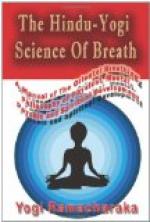The yogi cleansing breath.
The Yogis have a favorite form of breathing which they practice when they feel the necessity of ventilating and cleansing the lungs. They conclude many of their other breathing exercises with this breath, and we have followed this practice in this book. This Cleansing Breath ventilates and cleanses the lungs, stimulates the cells and gives a general tone to the respiratory organs, and is conducive to their general healthy condition. Besides this effect, it is found to greatly refresh the entire system. Speakers, singers, etc., will find this breath especially restful, after having tired the respiratory organs.
(1) Inhale a complete breath.
(2) Retain the air a few seconds.
(3) Pucker up the lips as if for a whistle (but do not swell out the cheeks), then exhale a little air through the opening, with considerable vigor. Then stop for a moment, retaining the air, and then exhale a little more air. Repeat until the air is completely exhaled. Remember that considerable vigor is to be used in exhaling the air through the opening in the lips.
This breath will be found quite refreshing when one is tired and generally “used up.” A trial will convince the student of its merits. This exercise should be practiced until it can be performed naturally and easily, as it is used to finish up a number of other exercises given in this book, and it should be thoroughly understood.
THE YOGI NERVE VITALIZING BREATH.
This is an exercise well known to the Yogis, who consider it one of the strongest nerve stimulants and invigorants known to man. Its purpose is to stimulate the Nervous System, develop nerve force, energy and vitality. This exercise brings a stimulating pressure to bear on important nerve centers, which in turn stimulate and energize the entire nervous system, and send an increased flow of nerve force to all parts of the body.
(1) Stand erect.
(2) Inhale a Complete Breath, and retain same.
(3) Extend the arms
straight in front of you, letting them
be somewhat limp and
relaxed, with only sufficient nerve
force to hold them out.
(4) Slowly draw the hands back toward the shoulders, gradually contracting the muscles and putting force into them, so that when they reach the shoulders the fists will be so tightly clenched that a tremulous motion is felt.
(5) Then, keeping the
muscles tense, push the fists slowly
out, and then draw them
back rapidly (still tense) several
times.
(6) Exhale vigorously through the mouth.
(7) Practice the Cleansing Breath.
The efficiency of this exercise depends greatly upon the speed of the drawing back of the fists, and the tension of the muscles, and, of course, upon the full lungs. This exercise must be tried to be appreciated. It is without equal as a “bracer,” as our Western friends put it.




